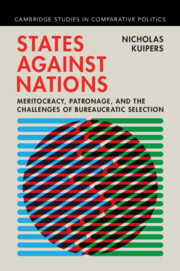Refine search
Actions for selected content:
538 results

Marketing Channel Management
- Organization and Coordination
- Coming soon
-
- Expected online publication date:
- November 2025
- Print publication:
- 04 December 2025
-
- Textbook
- Export citation
Case 31
-
- Book:
- Debating Papal History, c. 250–c. 1300
- Published online:
- 03 November 2025
- Print publication:
- 20 November 2025, pp 277-288
-
- Chapter
- Export citation
Plant genebank of Sudan: Towards recovery from the wreckage of war to a new era of further capacity development based on lessons learnt from similar situations
-
- Journal:
- Plant Genetic Resources , First View
- Published online by Cambridge University Press:
- 11 November 2025, pp. 1-7
-
- Article
-
- You have access
- Open access
- HTML
- Export citation
13 - Decision Making Involving Disputes, Negotiation, and Conflict
- from Part III - Applications, Examples, and Selected Topics
-
- Book:
- Making Decisions: Analytics, Cognition, and Application
- Published online:
- 23 October 2025
- Print publication:
- 06 November 2025, pp 183-201
-
- Chapter
- Export citation
Estimating the Impact of Drone Strikes on Civilians Using Call Detail Records
-
- Journal:
- British Journal of Political Science / Volume 55 / 2025
- Published online by Cambridge University Press:
- 04 November 2025, e150
-
- Article
-
- You have access
- Open access
- HTML
- Export citation
Evolution of child acute malnutrition during war in the Gaza Strip, 2023-2024: retrospective estimates and scenario-based projections
-
- Journal:
- British Journal of Nutrition / Accepted manuscript
- Published online by Cambridge University Press:
- 03 November 2025, pp. 1-27
-
- Article
-
- You have access
- Export citation
Chapter 9 - Personality and Individual Differences in Conversation Memory
-
- Book:
- Conversation Memory
- Published online:
- 09 October 2025
- Print publication:
- 23 October 2025, pp 124-131
-
- Chapter
- Export citation
CONFLICTS, COMPROMISES, AND THE ECONOMY
-
- Journal:
- National Institute Economic Review ,
- Published online by Cambridge University Press:
- 23 October 2025, pp. 1-7
-
- Article
- Export citation
8 - Animal Rights and One Health
- from Part II - One Health and Contemporary Legal Structures
-
-
- Book:
- The Cambridge Handbook of One Health and the Law
- Published online:
- 25 September 2025
- Print publication:
- 09 October 2025, pp 104-122
-
- Chapter
- Export citation
Chapter 8 - Societies as Ecosystems
- from Part II - The New Psychology of Intergroup Relations
-
- Book:
- The Psychology of System Change and Resistance to Change
- Published online:
- 23 September 2025
- Print publication:
- 09 October 2025, pp 163-184
-
- Chapter
- Export citation
Chapter 2 - Creating and Resisting Change as Disadvantaged Groups
- from Part I - Intergroup Relations and Group Processes
-
- Book:
- The Psychology of System Change and Resistance to Change
- Published online:
- 23 September 2025
- Print publication:
- 09 October 2025, pp 26-50
-
- Chapter
- Export citation
5 - Conflicting Medicines and the Politicization of Health
-
- Book:
- Palestinian Doctors
- Published online:
- 12 September 2025
- Print publication:
- 02 October 2025, pp 147-177
-
- Chapter
- Export citation
1 - Theorizing Regionally Dominant Political and Moral Economies as Causes of Deforestation
- from Part I - Introduction
-
- Book:
- Clearcut
- Published online:
- 03 October 2025
- Print publication:
- 02 October 2025, pp 3-30
-
- Chapter
-
- You have access
- Open access
- HTML
- Export citation
Ecologies of Violence: Heritage and Conflict in More-than-Human Worlds
-
- Journal:
- Antiquity , First View
- Published online by Cambridge University Press:
- 26 September 2025, pp. 1-6
-
- Article
-
- You have access
- Open access
- HTML
- Export citation
A hybrid classification approach for exploring Iraq’s welfare regime
-
- Journal:
- Journal of International and Comparative Social Policy / Volume 41 / Issue 2 / July 2025
- Published online by Cambridge University Press:
- 24 September 2025, pp. 160-180
-
- Article
-
- You have access
- Open access
- HTML
- Export citation
Management of Embedded Unexploded Ordnance in Low-resource Settings: A Scoping Review – ADDENDUM
-
- Journal:
- Disaster Medicine and Public Health Preparedness / Volume 19 / 2025
- Published online by Cambridge University Press:
- 05 September 2025, e258
-
- Article
-
- You have access
- Open access
- HTML
- Export citation
25 - Successfully managing conflict
- from Part 5 - Drives Innovation
-
-
- Book:
- Leading and Managing Health Services
- Published online:
- 15 August 2025
- Print publication:
- 28 August 2025, pp 276-286
-
- Chapter
- Export citation

States against Nations
- Meritocracy, Patronage, and the Challenges of Bureaucratic Selection
-
- Published online:
- 14 August 2025
- Print publication:
- 07 August 2025
Beyond the Rubble: Civil Society Organizations’ Emergency Response to Protect Cultural Heritage in Conflict Areas
-
- Journal:
- Advances in Archaeological Practice / Volume 13 / Issue 1 / February 2025
- Published online by Cambridge University Press:
- 13 August 2025, pp. 89-112
-
- Article
-
- You have access
- Open access
- HTML
- Export citation
Silent scars: how armed conflict is traumatising Kashmir’s children, and the need for critical intervention
-
- Journal:
- The British Journal of Psychiatry , FirstView
- Published online by Cambridge University Press:
- 11 August 2025, pp. 1-2
-
- Article
-
- You have access
- HTML
- Export citation
